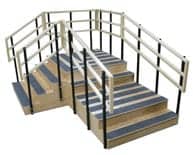By Francesco Amico, PhD
Surface electromyogram (sEMG) biofeedback is a learning-based form of therapy that helps both retrain skeletal (voluntary) muscles and increase muscle tone awareness, by creating a real-time feedback cycle between muscle activity and voluntary muscle control. sEMG biofeedback places electrodes on the surface of the skin over muscles to detect changes in electrical activity that are then fed back to the user in the form of visual or auditory stimuli. Improved muscle performance can then be gradually achieved voluntarily by monitoring and correcting the discrepancy between detected and standard/normative muscle activity parameters. sEMG biofeedback has been shown to increase muscular strength and activation by improving the recruitment of muscle fibers and by optimizing their activity in response to signals and mechanisms generated by the central nervous system (CNS).
Biofeedback as Recovery Aid
Biofeedback has been used for over 50 years in sports rehabilitation as a stand-alone or complementary intervention, with studies indicating symptom improvements in athletes with joint pain following joint/muscle injuries, and with postsurgery joint/muscle weakness. Based on the detection, monitoring, and synergistic modulation of neuromuscular, respiratory, and cardiovascular activity, sEMG biofeedback provides noninvasive (no injection, or surgery needed) training of the CNS to exert optimal control over muscle groups at rest (isometric training) and in motion. In doing so, sEMG biofeedback provides personalized training protocols based on measurable data, increases patient engagement throughout the rehabilitation process, and offers patients the opportunity to gain greater control over the muscles being trained, when compared with standard rehabilitation programs.
While the physical aspects of injury are usually the main concern in sports rehabilitation, studies show that the recovery process in athletes requires more than physical healing, and that treatment protocols should also take into account the cognitive and emotional distress that is often associated with injuries and postoperative stages. Both pre- and postinjury factors, as well as several personal (eg, history, severity, and type of past injury) and situational (eg, type of sport and proficiency) variables often influence how athletes respond to injuries and also how easily they heal. In this respect, personalized biofeedback protocols aimed at normalizing heart rate variability (HRV) can also assist the recovering athlete throughout the rehabilitation process.
When using an sEMG biofeedback device for strengthening muscles, the user sets a performance goal for the target muscle so that voluntary effort is required to start and complete each contraction. Detailed feedback on performance (strength and speed of contraction) is provided in real time by the device, while gradually providing more challenging goals.
An additional feature is the use of sEMG-triggered muscle stimulation, whereby users with low sEMG levels are gradually assisted through stimulation of the target muscle when the target threshold is reached.
One company has developed a state-of-the-art sEMG biofeedback system that features a handheld device equipped with sEMG sensors that provide the measurement and display of muscle activity in real time. This information can then be used by the physical therapist to selectively train muscle groups and ensure that performance goals are reached throughout the intervention. RM
Francesco Amico, PhD, is a behavioral neuroscientist with over 20 years of experience in neuropsychological research. His original work focuses on the development of novel technology to improve the diagnosis and treatments of neurological/neuropsychiatric disorders. He also regularly collaborates with clinics throughout North America providing consultancy on neurofeedback training.
References
- Alonazi A, Hasan S, Anwer A, et al. Efficacy of electromyographic-biofeedback supplementation training with patellar taping on quadriceps strengthening in patellofemoral pain syndrome among young adult male athletes. Int J Environ Res Public Health. 2021;18(9).
- Gabler C, Kitzman PH, Mattacola CG. Targeting quadriceps inhibition with electromyographic biofeedback: a neuroplastic approach. Crit Rev Biomed Eng. 2013;41(2):125-35.
- Evans L, Wadey R, Hanton S, Mitchell I. Stressors experienced by injured athletes. J Sports Sci. 2012;30(9):917-27.
- Wiese-Bjornstal DM, Smith AM, Shaffer SM, Morrey MA. An integrated model of response to sport injury: psychological and sociological dynamics. J Appl Sport Psychol. 2008;10:46-69.
- Rollo S, Tracey J, Prapavessis H. Effects of a heart rate variability biofeedback intervention on athletes psychological responses following injury: a pilot study. Int J Sports Exerc Med. 2017;3.
- Giggins OM, Persson UM, Caulfield B. Biofeedback in rehabilitation. J Neuroeng Rehabil. 2013;10:60.





